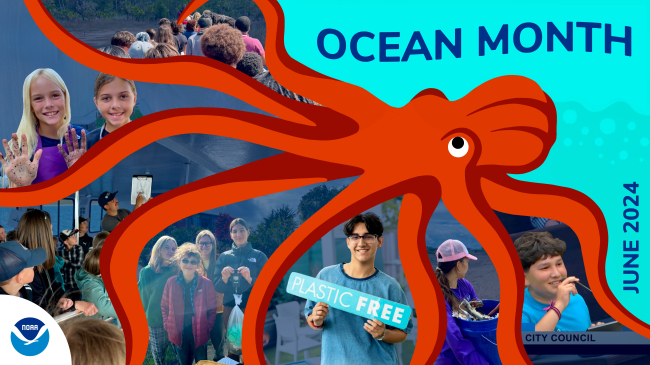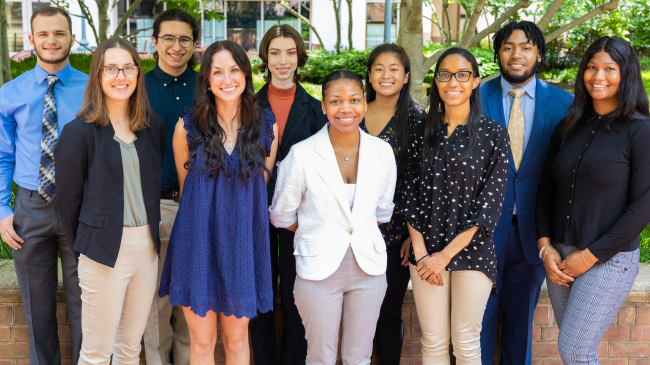An operational shift at the National Weather Service (NWS) is better meeting the needs of the American public, including vulnerable populations, and is building a Weather-Ready Nation. Part of that shift includes learning from communities how agency-generated information was used to stay safe from weather, water, and climate-related hazards during a weather event. One of those events happened in 2010 and for the last decade, two NWS meteorologists with a unique set of skills have been working with the Deaf and hard of hearing community to ensure they are weather-ready.
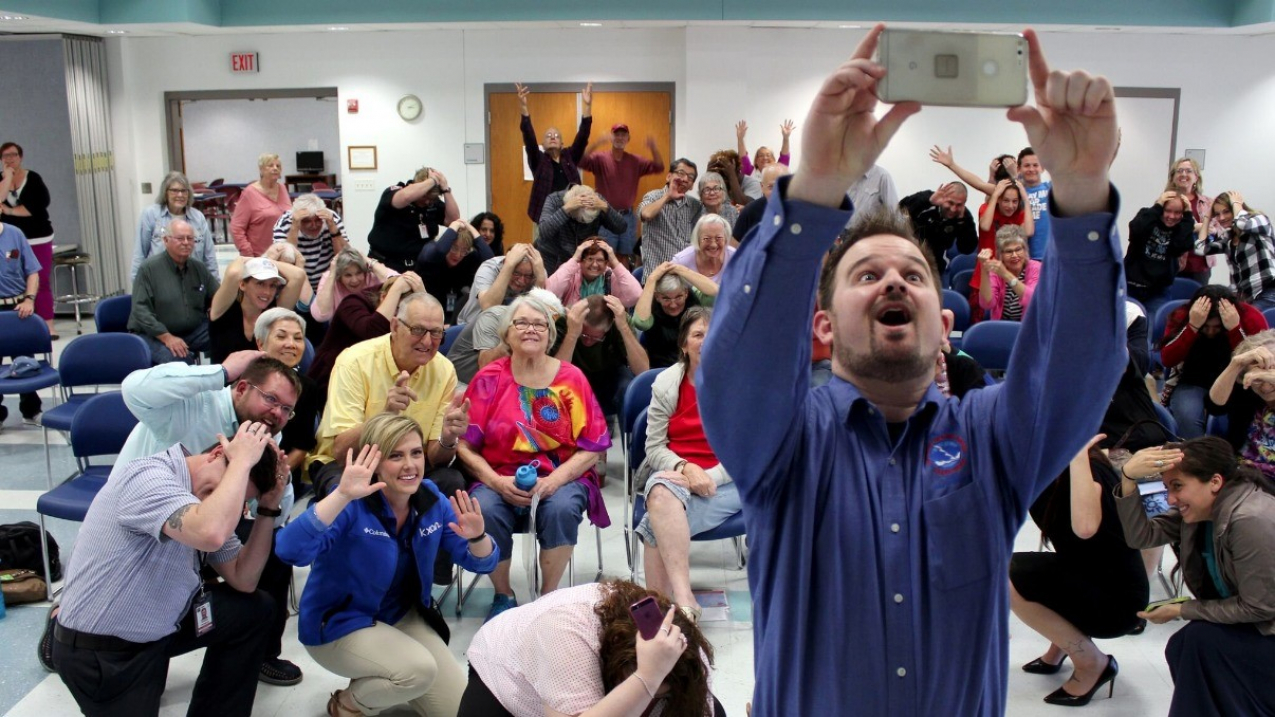
National Weather Service meteorologist Trevor Boucher takes a group selfie during the Town Hall for Texas School for the Deaf and Austin Deaf Senior Citizens about weather hazards and weather safety. This photo was taken on November 19, 2018. (Image credit: Courtesy of Trevor Boucher/National Weather Service)
On May 1-2, 2010, more than 13 inches of rain fell over Nashville, Tennessee, causing major flooding that damaged 11,000 structures. In the days leading up to the deluge, the NWS issued forecasts that were discussed at length by broadcast and operational meteorologists. As flood waters rose in the Cumberland River, NOAA Weather Radios sounded the alarm, alerting many residents to the impending danger.
But as the warnings blared on radios and interrupted television broadcasts, the Deaf community in Tennessee received little warning. Even as the city began the arduous recovery process, members of the Deaf community did not receive aid because they weren’t aware that first responders were knocking on their doors to provide it. NWS and other community partners realized that the barriers to effectively serve the Deaf and hard of hearing went way beyond the physical.
“What weather notifications are available that don’t require your hearing? I honestly didn’t know,” recalls Trevor Boucher, a NWS meteorologist who joined the Nashville Weather Forecast Office in the aftermath of the 2010 flooding. “I didn’t have any idea of how deep this project would be until I got there,” says Boucher.
Nashville, we have a problem
When Boucher applied to join the office, he was surprised that his interviewers asked as many — if not more — questions about his experience with American Sign Language (ASL) as they did about his background in meteorology. The Deaf community in Nashville had reached out to their local NWS office looking for someone who had ASL experience and could work with them.
After he settled into his new job with NWS in Nashville, Boucher served as one of many partners, including Deaf and hard-of-hearing individuals and advocacy groups, that came together to provide better emergency services to the hearing loss population in Middle Tennessee. They, in-turn, formed the Emergency Awareness and Readiness Services (EARS) Consortium.
They had a big job ahead of them. Simple questions came in from the Deaf community — “How am I supposed to listen to a weather radio? Where do I find weather warning information?” — but no one had the answers.
All EARS for weather safety
Although no one organization or individual had all the answers, each EARS partner could provide a different aspect of service. Together, they began assembling a plan for providing hazardous weather notifications to the Deaf: The Nashville Metro Public Health Department had grant funding specifically earmarked for vulnerable populations, and they could use it to purchase NOAA Weather Radios with strobe lights and vibrating bed shaker attachments. Vanderbilt University, another EARS partner, offered to produce a video to teach people how to program and use the radios. Bridges, a local outreach and advocacy group, provided ASL interpreters for the training videos. NWS pitched in by providing a script with weather safety information.
EARS hosted a day-long training event at the local Nashville Red Cross auditorium where the adapted weather radios were distributed to 150 Deaf households. Before participants received their free radios, they took a SKYWARN Spotter Training, weather safety and preparedness training, and safety kit demonstration, all of which were captioned in English and interpreted in ASL. The response from the radio giveaway was overwhelming. Boucher fielded questions for several hours after the event was over. “That was just the beginning,” he says.
Watch the Weather Radio programming video.
Next stop, Alabama
Enter Jennifer Saari, a meteorologist at the neighboring Weather Forecast Office in Huntsville, Alabama. After assisting a group of Deaf individuals at a local weather radio programming event and hearing about the recent event just two hours north in Nashville, Saari reached out to Boucher to explore serving the Deaf community in northern Alabama. Boucher traveled to Huntsville to help establish a partnership with the Alabama Institute for the Deaf and Blind and Alabama Department of Rehabilitation Services. Shortly thereafter, Saari hosted the first SKYWARN training for the Deaf and hard of hearing community of northern Alabama. Since then, she has expanded the Deaf SKYWARN program across the entire state, working with staff from NWS forecast offices in Birmingham and Mobile.
Through additional partnerships with the Alabama Department of Public Health, participants have a better understanding of weather and weather safety and received a free weather radio with a strobe light attachment. Local TV meteorologists and emergency management agencies also attended the classes, providing opportunity for everyone to ask questions and learn from each other.

A lightning bolt moment
During her first class, Saari quickly realized that the national lightning safety slogan, “When Thunder Roars, Go Indoors!” wouldn’t work for the Deaf community. Not only did this slogan emphasize the need to hear thunder, it also relied on catchy rhyming in English — a technique that doesn’t translate to ASL.
Saari and Boucher worked with their local partners and community to develop a more visual approach to lightning safety. Ideas were presented and refined over the course of four years. The end result was the slogan, “See a Flash, Dash Inside!” with an associated logo and Public Service Announcement (PSA). The logo was finalized by a Deaf graphic design artist, and the PSA featured an interpreter with open captioning to allow for better accessibility.
“See a Flash, Dash Inside!” was nationally rolled out by NOAA and NWS in June 2016, along with social media materials in the Weather-Ready Nation spring and summer safety campaigns.
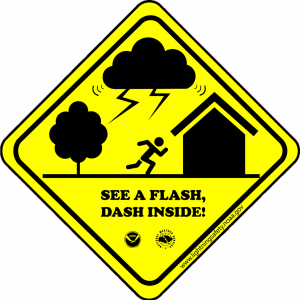
NWS Deaf outreach goes nationwide
The grassroots efforts to serve the Deaf community in Tennessee and Alabama were an excellent start, but both Saari and Boucher understood that similar efforts were needed across the country. They started an ad-hoc Deaf and Hard of Hearing Outreach Team and recruited NWS forecasters who were interested in beginning grassroots efforts in their own communities. More than nine years later, outreach efforts have expanded across the National Weather Service, with annual Spotter talks taking place in ASL and large public safety events with interpreters or captioning services provided.
In addition to these national efforts, local NWS offices are developing content specifically for the Deaf community. These ensure that weather safety information is fully accessible year-round, across the country. Videos on topics including rip currents, flood safety, and hurricane safety are featured on the Deaf and hard of hearing Weather-Ready Nation website so anyone, anywhere can use them.
Moving forward with new collaborations
The effort continues to expand through new partnerships and connections. In 2019, Saari worked with Dr. Darrin Griffin with the University of Alabama to collect data on how Deaf and hard of hearing communities use weather radios in Alabama and which adaptations, such as strobe lights or bed shakers, they prefer.
In January 2020, Saari traveled to NWS headquarters in Silver Spring, Maryland, to discuss the ongoing efforts to improve resiliency for vulnerable communities, specifically the Deaf and hard of hearing. Saari and a team from NOAA toured Gallaudet University, which was founded in 1864 in Washington, D.C., as the first school in the world for advanced education for the Deaf and hard of hearing. This meeting fortified a conduit for collaboration, as Gallaudet University sought to strengthen partnerships for disaster relief efforts and help guide students interested in the earth and environmental science fields.
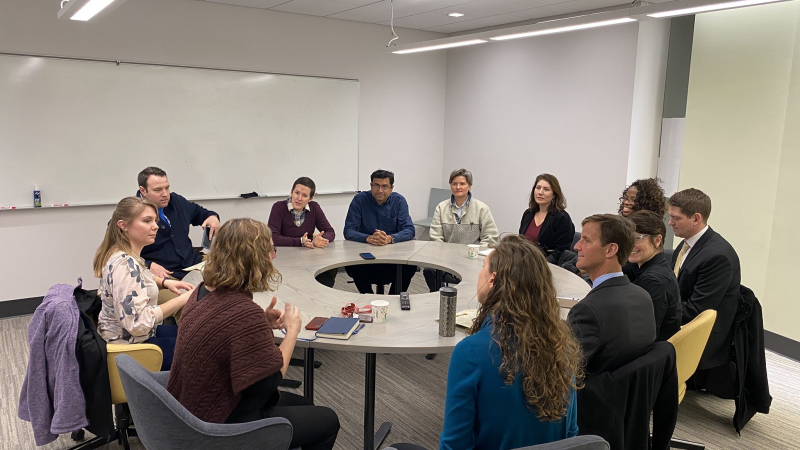
Becoming an advocate starts with recognizing the problem
As for Boucher, the work continues. Since his time at NWS Nashville, he has worked at NWS Austin/San Antonio and is currently a Lead Forecaster at NWS Las Vegas. He has continued his local outreach efforts by working with the Texas School for the Deaf in Austin and the Deaf Centers of Nevada in Las Vegas. Boucher is also advocating for the Deaf community to the overall weather enterprise. He has given multiple presentations at the American Meteorological Society (AMS) and National Weather Association conferences, including moderating a panel discussion on serving vulnerable populations at the AMS national conference in 2018.
Boucher and Saari’s efforts with the Deaf and hard of hearing community dovetail with the NWS goal of building a Weather-Ready Nation — a country of prepared citizens who are resilient to extreme weather events. Boucher credits active listening, a true interest in wanting to improve resilience in vulnerable populations, and continued outreach to the community for this positive evolution that will improve public safety.
“We’re immersing ourselves in their culture so we could learn more about their needs,” says Boucher. “While we’ve made great strides, there is more work — and more listening — to do, and we’re counting on the whole enterprise to help us do a better job going forward in serving all vulnerable populations.”
May 10, 2020, marks the 10th anniversary of the flooding in Tennessee. Now, as the NWS looks ahead to the next decade and beyond, it will be better able to serve all Americans. In the words of Boucher, “That’s the essence of a Weather-Ready Nation.”
A version of this story was featured in the Fiscal Year 2019 NOAA Education Accomplishments Report.



